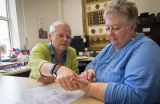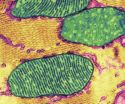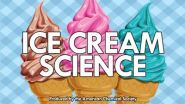(Press-News.org) Virginia Tech entomologists have developed a chromosome map for about half of the genome of the mosquito Aedes agypti, the major carrier of dengue fever and yellow fever.
With the map, researchers can compare the chromosome organization and evolution between this mosquito and the major carrier of malaria, the Anopheles gambiae mosquito, to find ways to prevent diseases.
"Despite looking somewhat similar, these mosquitoes diverged from each other about 150 million years ago. So, they are genetically further apart than humans and elephants," said Maria Sharakhova, a research scientist in the College of Agriculture and Life Sciences, a Fralin Life Science Institute affiliate, and the principal investigator of the study published in BMC Biology and highlighted on Biome.
The researchers say that the genome of the malaria mosquito is clearly separated into gene-rich and gene-poor compartments, while the genome of the yellow fever mosquito has no such differentiation. The study supports the observation that sex determination is also handled differently in the two mosquito species which could be useful in devising prevention measures.
In the malaria mosquito, X and Y chromosomes determine sex, but in the yellow fever mosquito, sex in males is determined just by a small location on chromosome 1.
Despite these differences, sex chromosome X in the malaria mosquito and chromosome 1 in the yellow fever mosquito evolve much faster than other chromosomes, meaning that the sex-determining segment of chromosome 1 may influence the rate of the change.
The discovery is significant because only female mosquitoes bite and transmit infectious diseases. Understanding the mechanisms of the sex chromosomes may help to manipulate the sex ratio in mosquitoes and reduce disease transmission.
"The development of novel approaches to disease control will be definitely more successful if we better understand the differences and similarities in the genomes of the yellow fever and malaria vectors," Sharakhova said.
Although the genome of the yellow fever mosquito was published in 2007, the lack of a detailed physical genome map prevented researchers from analyzing the chromosome genetic composition and evolution. The large size of the yellow fever mosquito's genome — about one third of the human genome size and five times larger than the malaria mosquito's genome — complicated genomic mapping efforts.
"The physical genome map developed in this study will guide efforts to significantly improve the genome assembly for the yellow fever mosquito and will facilitate more advanced studies of the genome organization and chromosome evolution in mosquitoes," said Igor Sharakhov, an associate professor of entomology in the College of Agriculture and Life Sciences, a Fralin Life Science Institute affiliate, and co-author on the paper.
INFORMATION:
Other study authors include Vladimir A. Timoshevskiy, a postdoctoral research associate in entomology in the College of Agriculture and Life Sciences; Nicholas Kinney of Leesburg, Virginia, a graduate student in the genetics, bioinformatics, and computational biology program at Virginia Tech; Zhijian Tu, a professor of biochemistry in the College of Agriculture and Life Sciences; Chunhong Mao, a senior project associate at the Virginia Bioinformatics Institute; David W. Severson, a professor of biological sciences at Eck Institute for Global Health of the University of Notre Dame, and Becky S. deBryun, a technician in the Severson laboratory.
Researchers map genomic differences in yellow fever, malaria mosquitoes
Genomic study reveals striking contrasts that may aid disease prevention
2014-06-17
ELSE PRESS RELEASES FROM THIS DATE:
Study reveals livestock gut microbes contributing to greenhouse gas emissions
2014-06-17
"Increased to levels unprecedented" is how the Intergovernmental Panel on Climate Change (IPCC) described the rise of carbon dioxide, methane and nitrous oxide emissions in their report on the physical science basis of climate change in 2013. According to the US Environmental Protection Agency (EPA), the atmospheric concentration of methane, a greenhouse gas some 28 times more potent than carbon dioxide has been steadily growing since the 18th century and has now increased by 50 percent compared to pre-industrial levels, exceeding 1,800 parts per billion.
The EPA attributes ...
'Vital signs' of teaching captured by quick, reliable in-class evaluation
2014-06-17
A 20-minute classroom assessment that is less subjective than traditional in-class evaluations by principals can reliably measure classroom instruction and predict student standardized test scores, a team of researchers researchers reported.
The assessment also provides immediate and meaningful feedback making it an important new tool for understanding and improving instructional quality, according to psychologists from the University of Rochester and the University of North Carolina at Chapel Hill.
"Education researchers broadly agree that teachers matter," explained ...
EHRA White Book 2014 highlights growing use of complex therapies for heart rhythm abnormalities
2014-06-17
Nice, France, 17 June 2014. The EHRA (European Heart Rhythm Association) White Book 2014 will be officially launched at the CARDIOSTIM EHRA EUROPACE 2014 congress which starts today in Nice, France.
The White Book reports on the current status of arrhythmia treatment in 49 of the 56 European Society of Cardiology (ESC) member countries for the year 2013. The new White Book is published in electronic format only and will be distributed on a USB stick as well as being available on the EHRA website. As a new feature, the USB stick contains complete data also from the six ...
Distracted minds still see blurred lines
2014-06-17
VIDEO:
Participants were asked to look at an image with moving sections blurred, while performing a cognitive 'n-back' task.
Click here for more information.
Montreal, June 17, 2014 — From animated ads on Main Street to downtown intersections packed with pedestrians, the eyes of urban drivers have much to see. But while city streets have become increasingly crowded with distractions, our ability to process visual information has remained unchanged for millions of years. ...
Pain pilot explores hand shiatsu treatment as sleep aid
2014-06-17
(Edmonton) There was a time, back in Nancy Cheyne's youth, when she combined the poise and grace of a ballerina with the daring and grit of a barrel racer. When she wasn't pursuing either of those pastimes, she bred sheepdogs, often spending hours on her feet grooming her furry friends at dog shows.
All that seems like a lifetime ago. After 15 years of living with chronic lower-back pain, Cheyne, 64, can't walk from the disabled parking stall to the elevator at work without stopping for a rest. She eats mostly junk food because it hurts too much to stand over the stove ...
Single dose reverses autism-like symptoms in mice
2014-06-17
In a further test of a novel theory that suggests autism is the consequence of abnormal cell communication, researchers at the University of California, San Diego School of Medicine report that an almost century-old drug approved for treating sleeping sickness also restores normal cellular signaling in a mouse model of autism, reversing symptoms of the neurological disorder in animals that were the human biological age equivalent of 30 years old.
The findings, published in the June 17, 2014 online issue of Translational Psychiatry, follow up on similar research published ...
Breast cancer diagnosis, mammography improved by considering patient risk: INFORMS paper
2014-06-17
A new approach to examining mammograms that takes into account a woman's health risk profile would reduce the number of cancer instances missed and also cut the number of false positives, according to a paper being presented at a conference of the Institute for Operations Research and the Management Sciences (INFORMS).
Mehmet U.S. Ayvaci of the University of Texas Dallas will present his research group's findings about the role of risk profiling in the interpretation of mammograms at Advances in Decision Analysis, a conference sponsored by the INFORMS Decision Analysis ...
Boost for dopamine packaging protects brain in Parkinson's model
2014-06-17
Researchers from Emory's Rollins School of Public Health discovered that an increase in the protein that helps store dopamine, a critical brain chemical, led to enhanced dopamine neurotransmission and protection from a Parkinson's disease-related neurotoxin in mice.
Dopamine and related neurotransmitters are stored in small storage packages called vesicles by the vesicular monoamine transporter (VMAT2). When released from these packages dopamine can help regulate movement, pleasure, and emotional response. Low dopamine levels are associated with neurodegenerative diseases ...
Gut bacteria predict survival after stem cell transplant, study shows
2014-06-17
(WASHINGTON, June 17, 2014) – New research, published online today in Blood, the Journal of the American Society of Hematology, suggests that the diversity of bacteria in the gastrointestinal tract of patients receiving stem cell transplants may be an important predictor of their post-transplant survival.
A healthy gastrointestinal tract contains a balanced community of microorganisms (known as microbiota), largely comprised of "friendly" bacteria that aid digestion and are important to immune system function. When this community of microbes is compromised, the microbiota ...
Ice cream chemistry: The inside scoop on a classic summer treat (video)
2014-06-17
WASHINGTON, June 17, 2014 — The summer weather is here, and if you've been out in the sun, you're probably craving some ice cream to cool off. In the American Chemical Society's latest Reactions video, American University Assistant Professor Matt Hartings, Ph.D., breaks down the chemistry of this favorite frozen treat, including what makes ice cream creamy or crunchy, and why it is so sweet. The video is available at http://youtu.be/-rlapUkWCSM
INFORMATION:
Subscribe to the series at Reactions YouTube, and follow us on Twitter @ACSreactions to be the first to see our ...
LAST 30 PRESS RELEASES:
Making lighter work of calculating fluid and heat flow
Normalizing blood sugar can halve heart attack risk
Lowering blood sugar cuts heart attack risk in people with prediabetes
Study links genetic variants to risk of blinding eye disease in premature infants
Non-opioid ‘pain sponge’ therapy halts cartilage degeneration and relieves chronic pain
AI can pick up cultural values by mimicking how kids learn
China’s ecological redlines offer fast track to 30 x 30 global conservation goal
Invisible indoor threats: emerging household contaminants and their growing risks to human health
Adding antibody treatment to chemo boosts outcomes for children with rare cancer
Germline pathogenic variants among women without a history of breast cancer
Tanning beds triple melanoma risk, potentially causing broad DNA damage
Unique bond identified as key to viral infection speed
Indoor tanning makes youthful skin much older on a genetic level
Mouse model sheds new light on the causes and potential solutions to human GI problems linked to muscular dystrophy
The Journal of Nuclear Medicine ahead-of-print tip sheet: December 12, 2025
Smarter tools for peering into the microscopic world
Applications open for funding to conduct research in the Kinsey Institute archives
Global measure underestimates the severity of food insecurity
Child survivors of critical illness are missing out on timely follow up care
Risk-based vs annual breast cancer screening / the WISDOM randomized clinical trial
University of Toronto launches Electric Vehicle Innovation Ontario to accelerate advanced EV technologies and build Canada’s innovation advantage
Early relapse predicts poor outcomes in aggressive blood cancer
American College of Lifestyle Medicine applauds two CMS models aligned with lifestyle medicine practice and reimbursement
Clinical trial finds cannabis use not a barrier to quitting nicotine vaping
Supplemental nutrition assistance program policies and food insecurity
Switching immune cells to “night mode” could limit damage after a heart attack, study suggests
URI-based Global RIghts Project report spotlights continued troubling trends in worldwide inhumane treatment
Neutrophils are less aggressive at night, explaining why nighttime heart attacks cause less damage than daytime events
Menopausal hormone therapy may not pose breast cancer risk for women with BRCA mutations
Mobile health tool may improve quality of life for adolescent and young adult breast cancer survivors
[Press-News.org] Researchers map genomic differences in yellow fever, malaria mosquitoesGenomic study reveals striking contrasts that may aid disease prevention




